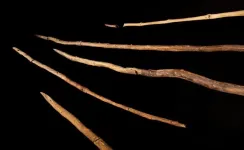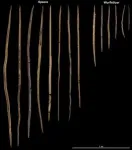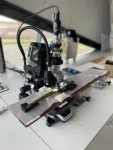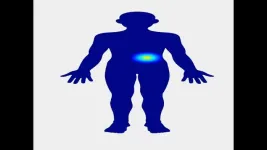(Press-News.org) During archaeological excavations in the Schöningen open-cast coal mine in 1994, the discovery of the oldest, remarkably well-preserved hunting weapons known to humanity caused an international sensation. Spears and a double-pointed throwing stick were found lying between animal bones about ten meters below the surface in deposits at a former lakeshore. In the years that followed, extensive excavations have gradually yielded numerous wooden objects from a layer dating from the end of a warm interglacial period 300,000 years ago. The findings suggested a hunting ground on the lakeshore. An interdisciplinary research team from the Universities of Göttingen and Reading (UK), and the Lower Saxony State Office for Cultural Heritage (NLD) has now examined all the wood objects for the first time. State-of-the-art imaging techniques such as 3D microscopy and micro-CT scanners have produced surprising results. The research was published in PNAS.
This is the first time that researchers have been able to demonstrate new ways of handling and working the wood, such as the “splitting technique”. Small pieces of split wood were sharpened, for example to use them in processing hunted animals. First author Dr Dirk Leder from NLD says: "There is evidence of much more extensive and varied processing of spruce and pine wood than previously thought. Selected logs were shaped into spears and throwing sticks and brought to the site, while broken tools were repaired and recycled on site." At least 20 spears and throwing sticks had been left behind on the former lakeshore. This doubles the number of known wooden weapons at the site. Dr Tim Koddenberg from the University of Göttingen explains: "The extraordinary state of preservation of the Schöningen wood has enabled us, for the first time, to document and identify the woodworking techniques in detail thanks to state-of-the-art microscopy methods.”
The wide range of woodworking techniques used, as well as the various weapons and tools of early humans, show the outstanding importance of wood as a raw material, which is almost never preserved from this period. The Schöningen finds bear witness to extensive experience in woodworking, technical know-how and sophisticated work processes. Project leader Professor Thomas Terberger, who works at the NLD and the University of Göttingen, states: "Wood was a crucial raw material for human evolution, but it is only in Schöningen that it has survived from the Palaeolithic period in such quality". Schöningen is therefore part of the internationally outstanding cultural heritage of early humans. Only recently, the site was included in the nomination list for UNESCO World Heritage Site at the request of the state of Lower Saxony.
The study was funded by the German Research Foundation (DFG) and the Ministry of Science and Culture of Lower Saxony.
Original publication: Dirk Leder et al. The wooden artifacts from Schöningen’s Spear Horizon and their place in human evolution. Proceedings of the National Academy of Sciences (2024). DOI: 10.1073/pnas.2320484121
Contact:
Professor Thomas Terberger
Lower Saxony State Office for Cultural Heritage
Scharnhorststraße1, 30175 Hanover
and
University of Göttingen
Department of Prehistory and Early History
Nikolausberger Weg 15, 37073 Göttingen
Email: thomas.terberger@phil.uni-goettingen.de
https://www.uni-goettingen.de/en/570533.html
Dr Tim Koddenberg
University of Göttingen
Department of Wood Biology and Wood Products
Büsgenweg 4, 37077 Göttingen
Email: tim.koddenberg@uni-goettingen.de
https://www.uni-goettingen.de/en/584651.html
During archaeological excavations in the Schöningen open-cast coal mine in 1994, the discovery of the oldest, remarkably well-preserved hunting weapons known to humanity caused an international sensation. Spears and a double-pointed throwing stick were found lying between animal bones about ten meters below the surface in deposits at a former lakeshore. In the years that followed, extensive excavations have gradually yielded numerous wooden objects from a layer dating from the end of a warm interglacial period 300,000 years ago. The findings suggested a hunting ground on the lakeshore. An interdisciplinary research team from the Universities of Göttingen and Reading (UK), and the Lower Saxony State Office for Cultural Heritage (NLD) has now examined all the wood objects for the first time. State-of-the-art imaging techniques such as 3D microscopy and micro-CT scanners have produced surprising results. The research was published in PNAS.
This is the first time that researchers have been able to demonstrate new ways of handling and working the wood, such as the “splitting technique”. Small pieces of split wood were sharpened, for example to use them in processing hunted animals. First author Dr Dirk Leder from NLD says: "There is evidence of much more extensive and varied processing of spruce and pine wood than previously thought. Selected logs were shaped into spears and throwing sticks and brought to the site, while broken tools were repaired and recycled on site." At least 20 spears and throwing sticks had been left behind on the former lakeshore. This doubles the number of known wooden weapons at the site. Dr Tim Koddenberg from the University of Göttingen explains: "The extraordinary state of preservation of the Schöningen wood has enabled us, for the first time, to document and identify the woodworking techniques in detail thanks to state-of-the-art microscopy methods.”
The wide range of woodworking techniques used, as well as the various weapons and tools of early humans, show the outstanding importance of wood as a raw material, which is almost never preserved from this period. The Schöningen finds bear witness to extensive experience in woodworking, technical know-how and sophisticated work processes. Project leader Professor Thomas Terberger, who works at the NLD and the University of Göttingen, states: "Wood was a crucial raw material for human evolution, but it is only in Schöningen that it has survived from the Palaeolithic period in such quality". Schöningen is therefore part of the internationally outstanding cultural heritage of early humans. Only recently, the site was included in the nomination list for UNESCO World Heritage Site at the request of the state of Lower Saxony.
The study was funded by the German Research Foundation (DFG) and the Ministry of Science and Culture of Lower Saxony.
Original publication: Dirk Leder et al. The wooden artifacts from Schöningen’s Spear Horizon and their place in human evolution. Proceedings of the National Academy of Sciences (2024). DOI: 10.1073/pnas.2320484121
Contact:
Professor Thomas Terberger
Lower Saxony State Office for Cultural Heritage
Scharnhorststraße1, 30175 Hanover
and
University of Göttingen
Department of Prehistory and Early History
Nikolausberger Weg 15, 37073 Göttingen
Email: thomas.terberger@phil.uni-goettingen.de
https://www.uni-goettingen.de/en/570533.html
Dr Tim Koddenberg
University of Göttingen
Department of Wood Biology and Wood Products
Büsgenweg 4, 37077 Göttingen
Email: tim.koddenberg@uni-goettingen.de
https://www.uni-goettingen.de/en/584651.html
END
Finds at Schöningen show wood was crucial raw material 300,000 years ago
Research team discovers sophisticated processing of archaeological wood
2024-04-04
ELSE PRESS RELEASES FROM THIS DATE:
Cells engineered to produce immune-boosting amino acids in prizewinning research
2024-04-04
Bacterial proteins often play a successful hide and seek game with the body’s immune system, making it difficult to combat the bacteria that cause diseases like staph infections.
Now, biomolecular engineer Aditya Kunjapur and colleagues have come up with a strategy to create bacteria that build and incorporate a key amino acid into their own proteins, which makes the proteins more “visible” to the immune system.
For this work toward building a better platform for possible future bacterial vaccines, Kunjapur is the winner of the 2024 BioInnovation Institute & Science Prize for Innovation. ...
Flexible fiber, coupled to the human body, enables chipless textile electronics
2024-04-04
A flexible electronic fiber that utilizes the human body as part of the circuit enables textile-based electronics without the need for batteries or chips, researchers report. According to the authors, the approach is well-suited for scalable manufacture of comfortable fiber-based electronics for a wide range of applications, including “smart” clothing. Textile electronic systems are designed to equip textile or fiber assemblies with electronic functions for sensing, computation, display, or communication. They create vast opportunities ranging from physiological monitoring to powering ...
Governance frameworks should address the prospect of AI systems that cannot be safely tested
2024-04-04
In this Policy Forum, Michael Cohen and colleagues highlight the unique risks presented by a particular class of artificial intelligence (AI) systems: reinforcement learning (RL) agents that plan more effectively than humans over long horizons. “Giving [such] an advanced AI system the objective to maximize its reward and, at some point, withholding reward from it, strongly incentivizes the AI system to take humans out of the loop,” write Cohen and colleagues. This incentive also arises for long-term planning agents (LTPAs) more generally, say the authors, and in ways empirical testing is unlikely to cover. It is thus critical to address extinction risk from these ...
Revealed: Mechanical damage during an asthma attack
2024-04-04
In asthma, the tightening of muscles around the bronchi causes damage to the airway by squeezing and destroying epithelial cells, which promotes the airway inflammation and mucus production often associated with an asthma attack, researchers report. The findings suggest that preventing the mechanical damage caused by an asthma attack, rather than treating only its downstream symptoms, could pave the way for therapies that stop the whole asthma inflammatory cycle. Asthma is a common airway disorder affecting more than 300 million people worldwide. Although it is primarily considered an inflammatory disease, a diagnostic feature of asthma is mechanical bronchoconstriction – the ...
Agricultural diversification yields joint environmental and social benefits
2024-04-04
Promoting livestock biodiversity and soil conservation strategies provides both social and environmental benefits, according to a new study. The findings suggest that well-designed polices aimed at incentivizing the adoption of multiple diversification strategies could mitigate simplified agriculture’s negative environmental, health, and social impacts. “Our interdisciplinary analysis spanning a wide array of regions provides convincing evidence that agricultural diversification is a promising win-win strategy for providing social and environmental benefits,” write the authors. Agricultural lands tend to be simplified ecosystems designed ...
Nerve cells not entirely “young at heart”
2024-04-04
After two decades in the United States, Martin Hetzer returned home to Austria in 2023 to become the 2nd President of the Institute of Science and Technology Austria (ISTA). A year into his new role, the molecular biologist remains engaged in the realm of aging research.
Hetzer is fascinated by the biological puzzles surrounding the aging processes in organs like the brain, heart, and pancreas. Most cells comprising these organs are not renewed throughout a human’s entire life span. Nerve cells (neurons) in the human brain, for instance, can be as old as the organism, even ...
Discovery of how limiting damage from an asthma attack could stop disease
2024-04-04
Scientists at King’s College London have discovered a new cause for asthma that sparks hope for treatment that could prevent the life-threatening disease.
Most current asthma treatments stem from the idea that it is an inflammatory disease. Yet, the life-threatening feature of asthma is the attack or the constriction of airways, making breathing difficult. The new study, published today in Science, shows for the first time that many features of an asthma attack—inflammation, mucus secretion, and damage to the airway barrier that ...
Less extensive breast cancer surgery results in fewer swollen arms
2024-04-04
It is possible to leave most of the lymph nodes in the armpit, even if one or two of them have metastases larger than two millimetres? This is shown in a trial enrolling women from five countries, led by researchers at Karolinska Institutet and published in the New England Journal of Medicine. The results open up for gentler surgery for patients with breast cancer.
Breast cancer can spread to the lymph nodes in the armpit. However, tumours found only in the breast and armpit lymph nodes are considered a localized disease, with the goal of curing the patient.
A challenging question for breast cancer surgeons revolves around what should ...
Body mapping links our responses to music with their degree of uncertainty and surprise
2024-04-04
Music holds an important place in human culture, and we’ve all felt the swell of emotion that music can inspire unlike almost anything else. But what is it exactly about music that can bring on such intense sensations in our minds and bodies? A new study reported in the journal iScience on April 4 has insight from studies that systematically examine the way perception of unique musical chords elicits specific bodily sensations and emotions.
“This study reveals the intricate interplay between musical uncertainty, prediction ...
Shaking tiny clusters of brain cells, scientists reveal an overlooked protein’s role in traumatic brain injury
2024-04-04
Clinicians often find limited success in treating patients with traumatic brain injury, a condition long linked to contact sports and military services. A new study, published April 4 in the journal Cell Stem Cell, may offer new clues to better solutions. Scientists found a protein, TDP-43, that appears to drive nerve damage right after injury. Moreover, blocking a certain cell surface protein can correct faulty TDP-43 and curb nerve death in mouse and human cells.
“There’s really nothing out there that can prevent the injury ...
LAST 30 PRESS RELEASES:
NTP-enhanced lattice oxygen activation in Ce-Co catalysts for low-temperature soot combustion
Synergistic interface engineering in Cu-Zn-Ce catalysts for efficient CO2 hydrogenation to methanol
COVID-19 leaves a lasting mark on the human brain
Scientists use ultrasound to soften and treat cancer tumors without damaging healthy tissue
Community swimming program for Black youth boosts skills, sense of belonging, study finds
Specific depressive symptoms in midlife linked to increased dementia risk
An ‘illuminating’ design sheds light on cholesterol
Who is more likely to get long COVID?
Study showcases resilience and rapid growth of “living rocks”
Naval Research Lab diver earns Office of Naval Research 2025 Sailor of the Year
New Mayo-led study establishes practical definition for rapidly progressive dementia
Fossil fuel industry’s “climate false solutions” reinforce its power and aggravate environmental injustice
Researchers reveal bias in a widely used measure of algorithm performance
Alcohol causes cancer. A study from IOCB Prague confirms damage to DNA and shows how cells defend against it
Hidden viruses in wastewater treatment may shape public health risks, study finds
Unlock the power of nature: how biomass can transform climate mitigation
Biochar reshapes hidden soil microbes that capture carbon dioxide in farmland
Reducing saturated fat intake shows mortality benefit, but only in high-risk individuals
Manta rays create mobile ecosystems, study finds
Study: Mixed results in using lipoic acid to treat progressive multiple sclerosis
Norbert Holtkamp appointed director of Fermi National Accelerator Laboratory
New agentic AI platform accelerates advanced optics design
Biologists discover neurons use physical signals — not electricity — to stabilize communication
Researchers discover that a hormone can access the brain by hitchhiking
University of Oklahoma researcher awarded funding to pursue AI-powered material design
Exploring how the visual system recovers following injury
Support for parents with infants at pediatric check-ups leads to better reading and math skills in elementary school
Kids’ behavioral health is a growing share of family health costs
Day & night: Cancer disrupts the brain’s natural rhythm
COVID-19 vaccination significantly reduces risk to pregnant women and baby
[Press-News.org] Finds at Schöningen show wood was crucial raw material 300,000 years agoResearch team discovers sophisticated processing of archaeological wood





